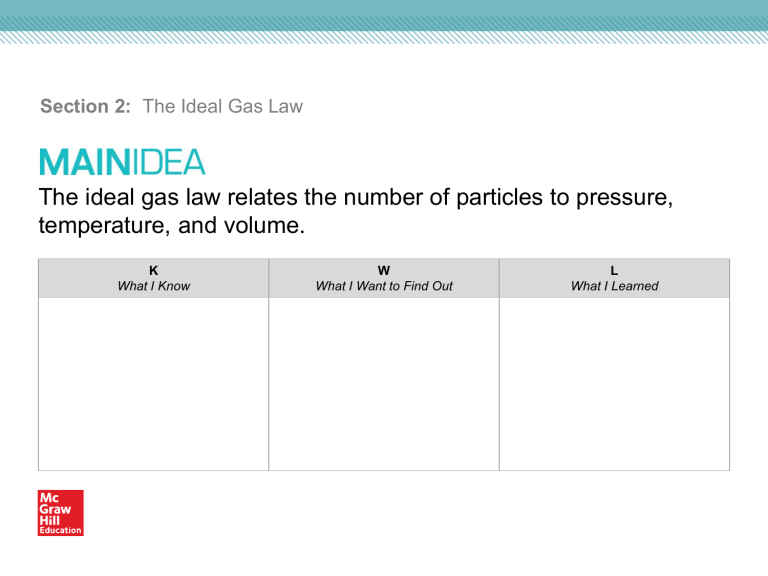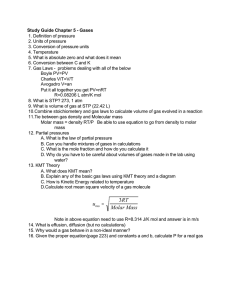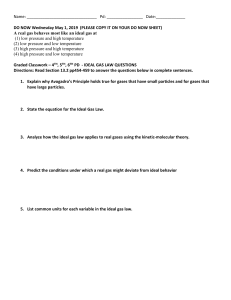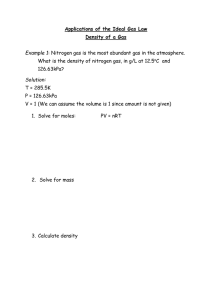
Section 2: The Ideal Gas Law The ideal gas law relates the number of particles to pressure, temperature, and volume. K What I Know W What I Want to Find Out L What I Learned Essential Questions • How does Avogadro’s principle relate the number of particles of gas to the gas’s volume? • How is the amount of gas present related to its pressure, temperature, and volume by the ideal gas law? • What are the properties of real gases and of ideal gases? Copyright © McGraw-Hill Education The Ideal Gas Law Vocabulary Review New • mole • Avogadro’s principle • molar volume • standard temperature and pressure (STP) • ideal gas constant (R) • ideal gas law Copyright © McGraw-Hill Education The Ideal Gas Law Avogadro's Principle • Avogadro’s principle states that equal volumes of gases at the same temperature and pressure contain equal numbers of particles. Copyright © McGraw-Hill Education The Ideal Gas Law Avogadro's Principle • The molar volume of a gas is the volume 1 mol occupies at 0.00°C and 1.00 atm of pressure. • 0.00°C and 1.00 atm are called standard temperature and pressure (STP). • At STP, 1 mol of gas occupies 22.4 L. Copyright © McGraw-Hill Education The Ideal Gas Law MOLAR VOLUME Use with Example Problem 5. KNOWN UNKNOWN Problem m = 2.00 kg V=?L The main component of natural gas used for home heating and cooking is methane (CH4). Calculate the volume that 2.00 kg of methane gas will occupy at STP. T = 0.00ºC Response ANALYZE THE PROBLEM The number of moles can be calculated by dividing the mass of the sample, m, by its molar mass, M. The gas is at STP (0.00°C and 1.00 atm pressure), so you can use the molar volume to convert from the number of moles to the volume. P = 1.00 atm SOLVE FOR THE UNKNOWN Determine the molar mass for methane. • Determine the molecular mass. M = 1 C atom 12.01 amu + 4H atoms 1 C atom 1.01 amu = 12.01 amu + 4.04 amu = 16.05 amu 1 H atom • Express the molecular mass as g/mol to arrive at the molar mass. = 16.05 g/mol Copyright © McGraw-Hill Education The Ideal Gas Law MOLAR VOLUME SOLVE FOR THE UNKNOWN (continued) EVALUATE THE ANSWER Determine the number of moles of methane. The amount of methane present is much more than 1 mol, so you should expect a large volume, which is in agreement with the answer. The unit is liters, a volume unit, and there are three significant figures. • Convert the mass from kg to g. 2.00 kg • 1000 g 1 kg = 2.00 × 103 g Divide mass by molar mass to determine the number of moles. m 2.00 × 103 g = = 125 mol M 16.05 g/mol Use the molar volume to determine the volume of methane at STP. • Use the molar volume, 22.4 L/mol, to convert from moles to the volume. V = 125 mol × Copyright © McGraw-Hill Education 22.4 L = 2.80 × 103 L 1 mol The Ideal Gas Law The Ideal Gas Law • Ideal gas particles occupy a negligible volume and are far enough apart to exert minimal attractive or repulsive forces on each other. • Combined gas law to ideal gas law Copyright © McGraw-Hill Education The Ideal Gas Law The Ideal Gas Law • The ideal gas constant is represented by R and is 0.0821 L•atm/mol•K when pressure is in atmospheres. • The ideal gas law describes the physical behavior of an ideal gas in terms of pressure, volume, temperature, and amount. Copyright © McGraw-Hill Education The Ideal Gas Law The Ideal Gas Law Copyright © McGraw-Hill Education The Ideal Gas Law THE IDEAL GAS LAW Use with Example Problem 6. Problem KNOWN UNKNOWN V = 3.0 L n = ? mol T = 3.00 × 102 K Calculate the number of moles of ammonia gas (NH3) contained in a 3.0-L vessel at 3.00 × 102 K with a pressure of 1.50 atm. P = 1.50 atm L·atm R = 0.0821 mol·K Response SOLVE FOR THE UNKNOWN ANALYZE THE PROBLEM You are given the volume, temperature, and pressure of a gas sample. Use the ideal gas law, and select the value of R that contains the pressure units given in the problem. Because the pressure and temperature are close to STP, but the volume is much smaller than 22.4 L, it would make sense if the calculated answer were much smaller than 1 mol. Use the ideal gas law. Solve for n, and substitute the known values. Copyright © McGraw-Hill Education • State the ideal gas law. PV = nRT • Solve for n. n= PV RT The Ideal Gas Law THE IDEAL GAS LAW SOLVE FOR THE UNKNOWN (continued) EVALUATE THE ANSWER • The answer agrees with the prediction that the number of moles present will be significantly less than 1 mol. The unit of the answer is the mole, and there are two significant figures. Substitute V = 3.0 L, T = 3.00 × 102 K, P = 1.50 atm, and R = 0.0821 L • atm/mol • K. n= • (1.50 atm)(3.0 L) 0.0821 L·atm (3.00 × 102 K) mol·K Multiply and divide numbers and units. n= (1.50 atm)(3.0 L) = 0.18 mol 0.0821 L·atm (3.00 × 102 K) mol·K Copyright © McGraw-Hill Education The Ideal Gas Law The Ideal Gas Law—Molar Mass and Density • Molar mass and the ideal gas law: Copyright © McGraw-Hill Education The Ideal Gas Law The Ideal Gas Law—Molar Mass and Density • Density and the ideal gas law: Copyright © McGraw-Hill Education The Ideal Gas Law Gases Go to your ConnectED resources to play Video Lab: Gases. Copyright © McGraw-Hill Education The Ideal Gas Law Real Versus Ideal Gases • Ideal gases follow the assumptions of the kinetic-molecular theory. • Characteristics of ideal gases: – There are no intermolecular attractive or repulsive forces between particles or with their containers. – The particles are in constant random motion. – Collisions are perfectly elastic. – No gas is truly ideal, but most behave as ideal gases at a wide range of temperatures and pressures. Copyright © McGraw-Hill Education The Ideal Gas Law Real Versus Ideal Gases • Real gases deviate most from ideal gases at high pressures and low temperatures. • Polar molecules have larger attractive forces between particles. • Polar gases do not behave as ideal gases. • Large nonpolar gas particles occupy more space and deviate more from ideal gases. Copyright © McGraw-Hill Education The Ideal Gas Law Gasses, Pressure and Scuba Diving Go to your ConnectED resources to play Video: Leagues Under the Sea. Copyright © McGraw-Hill Education The Ideal Gas Law Review Essential Questions • How does Avogadro’s principle relate the number of particles of gas to the gas’s volume? • How is the amount of gas present related to its pressure, temperature, and volume by the ideal gas law? • What are the properties of real gases and of ideal gases? Vocabulary • • Avogadro’s principle molar volume Copyright © McGraw-Hill Education • standard temperature and pressure (STP) • • ideal gas constant (R) ideal gas law The Ideal Gas Law





